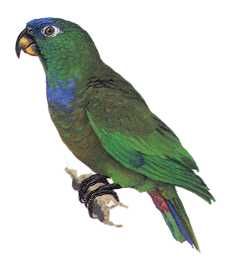 One of the Tower of London's ravens is seen roosting in 1996.
One of the Tower of London's ravens is seen roosting in 1996.Photo Credit: By Lynn Fergusson -- Reuters
For 350 years, coal-black ravens have wandered freely around the Tower of London's grassy inner courtyard as cawing barometers of the monarchy's vitality -- if the ravens ever die or leave the tower, the legend goes, the tower and the kingdom will fall.
Now the fear of bird flu has done what Luftwaffe bombings, blizzards, assassinations and abdications could not, forcing the ravens to be moved inside in isolation for their own safety and to hedge Britain's bets on the future of the crown.
On Tuesday, Hungarian officials confirmed that they had found the lethal H5N1 strain in three dead swans. With seven European countries now reporting cases of bird flu, including France, which is just 21 miles across the English Channel, concern is spreading in Britain. European officials met Tuesday in Brussels to discuss how to contain the virus, which has killed at least 92 people, mostly in Asia.
The British government has announced that plans are being prepared to put millions of free-range chickens indoors if the disease reaches British shores. But, quietly, the country's most famous birds were moved indoors last Wednesday night to custom-made aviaries. The names of the eight ravens currently in the tower are Gwylum, Thor, Hugine, Munin, Branwen, Bran, Gundulf, and Baldrick.
The move was made public this week by Her Majesty's Royal Palace and Fortress, as the tower is officially known, as visitors continue to inquire as to the whereabouts of one of the favorite features of the 900-year-old tower.
As thousands of visitors arrived Tuesday to view the famed Crown Jewels, several discussed the ravens that were seen no more. No one was saying nevermore would they be seen, but officials said the quarantine is not likely to be brief.
Now the fear of bird flu has done what Luftwaffe bombings, blizzards, assassinations and abdications could not, forcing the ravens to be moved inside in isolation for their own safety and to hedge Britain's bets on the future of the crown.
On Tuesday, Hungarian officials confirmed that they had found the lethal H5N1 strain in three dead swans. With seven European countries now reporting cases of bird flu, including France, which is just 21 miles across the English Channel, concern is spreading in Britain. European officials met Tuesday in Brussels to discuss how to contain the virus, which has killed at least 92 people, mostly in Asia.
The British government has announced that plans are being prepared to put millions of free-range chickens indoors if the disease reaches British shores. But, quietly, the country's most famous birds were moved indoors last Wednesday night to custom-made aviaries. The names of the eight ravens currently in the tower are Gwylum, Thor, Hugine, Munin, Branwen, Bran, Gundulf, and Baldrick.
The move was made public this week by Her Majesty's Royal Palace and Fortress, as the tower is officially known, as visitors continue to inquire as to the whereabouts of one of the favorite features of the 900-year-old tower.
As thousands of visitors arrived Tuesday to view the famed Crown Jewels, several discussed the ravens that were seen no more. No one was saying nevermore would they be seen, but officials said the quarantine is not likely to be brief.
* Read more from The Washington Post
* More on Ravens and Tower of London the from Wikipedia





